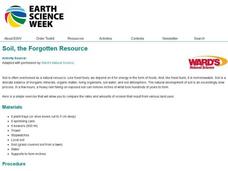Captain Planet Foundation
Rotting Away
What happens at the end of a plant's life cycle? Show kids the natural way that plants show that they're decomposing, as well as the importance of compost, with a lesson about living organisms. After reading Log Cabin by Anne Schreiber,...
Captain Planet Foundation
Sense of Place
Explore the five senses with a kindergarten lesson on gardening. After taking a walk through the class garden, kids note what they see, hear, feel, taste, and smell, and then decide what is living in the garden versus what is not living....
Teach Engineering
Clean it Up!
Harness the power of bacteria. Scholars see how using organisms that exist in nature can help solve human problems in the process known as bioremediation. They research and discuss several successful examples, such as using oil-eating...
Curated OER
Living and Non-Living Things in the Environment
Third graders examine living and non-living things and observe a plant growing in the classroom. There are many additional resources to assist learning and extension work, they can read books, interact with PowerPoint...
Curated OER
Dig Into Soil
Students discuss what is found in soil. In this science lesson, students observe the soil outside and write down information in regards to location, vegetation, and topography. Students experiment with the soil and its many properties...
Curated OER
Soil, the Forgotten Resource
Students discuss soil understanding that is is often overlooked as a natural resource. In this science lesson, students recognize that we depend on it for energy in the form of foods. Students experiment with six boxes of soil to help in...
Curated OER
Terrariums: A Look at the Living and Nonliving World
Third graders examine life in a terrarium and relate it to life in a larger environment. In this terrarium lesson, 3rd graders examine how living and non-living things work together by examining the changes in a terrarium. They make...
Curated OER
Living & Non-Living
In this living and non-living organisms worksheet, students read 5 informational signs and decide whether 10 objects or living or non-living and circle their answer underneath each one. Students participate in a scavenger hunt where they...
Curated OER
It's Alive!! Or, Is It?
In this cell activity, students complete 5 word scrambles and 8 true-false questions about the characteristics of living organisms and compounds found within cells.
Curated OER
Paper Towers
Students have the opportunity to use model-building as a way to help comprehend the forces and phenomena at work in the world around them. They describe gravity as a universal force that pulls everything toward the center of the earth....
Curated OER
What's In A Name?
Young scholars explore the concept of the binomial system of nomenclature for classifying organisms. Students travel on a field trip to observe organisms displayed and their common names. Young scholars complete several classroom...
Curated OER
Cell-to-Cell
Ninth graders use online tutorials, class discussion, presentations and scientific articles to explore types of cells along with cell structure, function and behavior. They explore ethical questions related to cells and disease.
Curated OER
Assignment on Life Processes
In this life processes activity, 8th graders create a children's book about the 7 functions of life that all living organisms have, complete with examples of living and non-living things.
Curated OER
Viruses Quiz
In this science worksheet, students will test their knowledge of viruses. Students answer ten multiple choice questions pertaining to virus characteristics.
Curated OER
Classifying Living and Non-Living Objects
Students investigate living organisms and define the properties of a living species. In this life characteristic lesson, students examine plants in their class and discuss whether or not they are alive. Students create a...
Curated OER
Living / Non-living
First graders shoot photographs of living and non-living things. In this living and non-living organism lesson, 1st graders discuss the attributes of living things, take digital photographs of living and non-living things, and design a...
Curated OER
Cells: The Units of Life
In this biology worksheet on cells, 9th graders name who the first person was to use the word cell and describe in what materials this person saw cells. Then they determine what instrument uses light and two or more lenses to view cells.
Curated OER
Investigating Local Ecosystems
Learners investigate the habitats of local plants and animals. They explore some of the ways animals depend on plants and each other. Students observe living organisms in a local ecosystem and create detailed drawings and descriptions...
Curated OER
Monitoring Energy Expenditure
Students use heart rate monitors and complete a swimming and running test. These tests allow students to obtain personal data, to manipulate the data through calculations of various parameters, and to graphically represent the data.
Curated OER
Living Organisms
First graders investigate living things that are part of a class aquarium. They make observations and answer guided questions about each organism. Students read a Science textbook and engage in a class discussion about the content. Then...
Curated OER
Living Organisms
Third graders examine pond water samples using hand lenses while working in small groups. They find specimens of living organisms in the water samples. Finally, the draw a picture of the organisms and label them using descriptive...
Curated OER
Is It Alive?
Eighth graders define the boundaries of living organisms. They determine what makes something a living organism and identify factors that constitute "living." Pupils write a conclusion about the evidence they found that yeast is alive...
Curated OER
Viruses and Host Evolution
Students research viruses and their effects on the evolution of a rabbit population. They complete a teacher created worksheet of questions on their research. They present their research to classmates.
Curated OER
Field Trip to School
Students better explain the diversity and adaptations of living organisms.

























